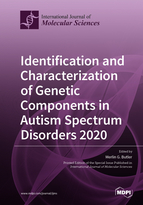Identification and Characterization of Genetic Components in Autism Spectrum Disorders 2020
A special issue of International Journal of Molecular Sciences (ISSN 1422-0067). This special issue belongs to the section "Molecular Genetics and Genomics".
Deadline for manuscript submissions: closed (30 January 2021) | Viewed by 66107
Special Issue Editor
Interests: Prader-Willi syndrome; fragile X syndrome; microdeletion syndromes; autism spectrum disorders; genetics of autism; obesity and intellectual disability; chromosomal microarray analysis; next generation sequencing; delineation of rare genetic disorders; genotype-phenotype relationships
Special Issues, Collections and Topics in MDPI journals
Special Issue Information
Dear Colleagues,
This journal issue is dedicated to the study of autism due to genetic factors, and will publish a collection of original research or review articles and studies related to this topic. Highlights in the field of autism research and the early identification and characterization of genetic components will be addressed. Autism spectrum disorders (ASD) are neurobehavioral disorders characterized by three behavioral domains and currently affect about 1% of children; they are, however, on the rise. Significant genetic contributions, factors and mechanisms underlie the causation of ASD. About 50% of individuals are diagnosed with chromosomal abnormalities, submicroscopic deletions or duplications, single gene disorders or variants and metabolic disturbances. The advancement of genetic technology with high resolution structural and microarrays with bioinformatics has led to the identification of well over 800 genes contributing to or associated with ASD. Further, next generation sequencing and other advances in diagnosing ASD at an early age may lead to potential pharmaceutical intervention/treatment that may vary from patient to patient depending on the specific structural and genomic findings, disturbed pathways and function with the associated characteristics of autism. New discoveries and the continued identification of candidate genes will be addressed, as will genotype–phenotype correlations. Evaluations requiring the use of advanced genetic testing options will be discussed along with psychiatric/behavioral co-morbidities, and a better delineation of ASD and approaches to treatment.
Prof. Dr. Merlin G. Butler
Guest Editor
Manuscript Submission Information
Manuscripts should be submitted online at www.mdpi.com by registering and logging in to this website. Once you are registered, click here to go to the submission form. Manuscripts can be submitted until the deadline. All submissions that pass pre-check are peer-reviewed. Accepted papers will be published continuously in the journal (as soon as accepted) and will be listed together on the special issue website. Research articles, review articles as well as short communications are invited. For planned papers, a title and short abstract (about 100 words) can be sent to the Editorial Office for announcement on this website.
Submitted manuscripts should not have been published previously, nor be under consideration for publication elsewhere (except conference proceedings papers). All manuscripts are thoroughly refereed through a single-blind peer-review process. A guide for authors and other relevant information for submission of manuscripts is available on the Instructions for Authors page. International Journal of Molecular Sciences is an international peer-reviewed open access semimonthly journal published by MDPI.
Please visit the Instructions for Authors page before submitting a manuscript. There is an Article Processing Charge (APC) for publication in this open access journal. For details about the APC please see here. Submitted papers should be well formatted and use good English. Authors may use MDPI's English editing service prior to publication or during author revisions.
Keywords
- microarray
- next generation sequencing
- copy number variants (CNVs)
- candidate genes
- candidate genes
- gene polymorphisms and variants
- single gene disorders associated with ASD
- epigenetics
- genetic causation
- gene expression
- non-coding RNAs
- biomarkers
- treatment
Related Special Issues
- Identification and Characterization of Genetic Components in Autism Spectrum Disorders 2019 in International Journal of Molecular Sciences (13 articles)
- The Identification of the Genetic Components of Autism Spectrum Disorders 2017 in International Journal of Molecular Sciences (18 articles)
- The Identification of the Genetic Components of Autism Spectrum Disorders in International Journal of Molecular Sciences (10 articles)







